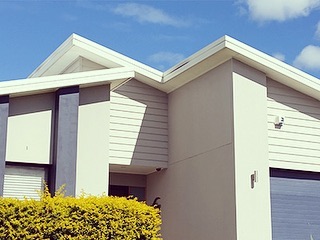With literally thousands of different finishes possible across multiple different suppliers, we have found that apart from some infrequent features, render finishes in Sydney can be categorised into 2 main types of finishes – Acrylic Render or Sponge Finish Render.
As simplistic as this sounds, both categories in themselves, are made up of an extensive range of grain size and finishes. We’re happy to help you navigate through the noise as we progress, but for the time being, and for the purposes of assisting the widest possible reach with information – we’ll stick to the most common.
Acrylic Render
Over certain substrates ( predominantly light weight claddings such as polystyrene, Hebel™, and fibre cement, The proposed render system will already include an Acrylic Render topcoat.
That’s because of the incredible ability that Acrylic Render had when it comes to flexibility! An Acrylic Render topcoat gives the ultimate protection against hairline cracking to the cement rendering base coat. As well as giving a uniform, consistent finish that looks like it was completed in a factory!
When you have a masonry substrate such as concrete block, off form concrete, or even just clay brick – Acrylic Render is an option only a small percentage of people opt for. Whilst any added protection against substrate hairline cracking is always welcomed, the cost typically outweighs the benefit, given the generally stable conditions in a masonry wall compared with a lightweight cladding.
When it is recommended is where existing hairline cracks through the brick/block work are evident ( or expected), or where a project has adjoining lightweight cladding substrates ( with an Acrylic Render as the topcoat), and the subtle texture difference is not tolerable.
While the general finish is typically ‘grainier” than that of a traditional ‘sponged finish’, it doesn’t have to be! The rule of thumb here is that the size of the aggregate, or in this case the sand particle, determines allot to do with the overall dry film thickness ( DFT). It’s this DFT that plays the part in render systems added flexibility. But don’t be put off by grain size up close, remember the normal viewing position of a rendered wall is more than 1500mm, and certainly by the time you get past this point render, with just about any size grain, just gives the illusion of a clean, flat, seamless surface.
For those that select an Acrylic Render, you wont be dissapointed. That added water resistance, flexibility, and resilience is only shadowed by the ability to tint the product to any Australian paint colour – after all its pure acrylic!
Sponged Finish
That brick house you seen get rendered around the corner… High chance it got finished to what they call a ‘Sponged Finish’ That’s because when it comes to render, it’s the most popular finish around – and it has been for centuries!
When you see it done, it’s not too hard to figure out where the name comes from. A sponged finish is a traditional way to finish a wall concealing the float marks from the previous step, while also drawing out the sand grain to give it a smooth appearance with a subtle grain.
Ofcourse, with bagged mixed renfer, as with Acrylic Render, comes the choice in size of various graded sand particles. The grain size suggested is determined by the desired aesthetic look, however, there seems to be a ‘standard’ across all major manufacturers that tend to leave a finish that has the appearance of a fine sandpaper, and ticks the box for most people’s tastes.
The finished sponed render is left raw, and under typical drying conditions is ready for painting as early as 48 hours after the app;the application. Of course, if you are doing the painting yourself, you may want to tell your loved one its a 6 week curing time (typical in the previous era of site mixed renfers), just to buy yourself a little breathing space.
Whilst it is leaps and bounds in front of old site mixed sand and cement, it lacks the benefits of an Acrylic Render and therefore is only recommended to be used on sound masonry substrates. That being said, more than half of or work gets finished to a ‘Spinged FInish’ and along with the subsequent paint coats – is typically a more economical way to achieve a coloured finish.



